
THE
PASTORAL -
BETWEEN
THE SACRED AND THE PROFANE
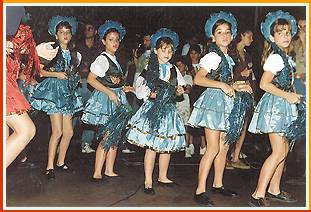
THE
VICTORIA REGIS PASTORAL . Newspaper
photo archives |
 |
Throughout the research
dedicated to the dramatic manifestations that in some way express the
Brazilian people, principally the
dramatic dances, it is a proven fact that all the origins are of a
religious nature, and not profane. Gilberto Freyre and Mario de Andrade, for example, are unanimous in affirming that, even when
their basis or links are attributed to economic factors, these
popular artistic manifestations, together with any of their
variants, originate from religious mysticism. |
One
further important characteristic highlighted by Mario de Andrade in "Dramatic
Brazilian Dances" is that - "within the majority of our
dramatic representations, we either encounter death and resurrection as
the main theme or, as in the case of the Pastorals (and the Cheganças - a
typical Northeastern dance manifestation),
the fight between good and bad, thus characterizing the notion of danger
and salvation".
In the pastorals that originate
from the Iberian Peninsular, the concept of death and resurrection does not
appear in a definitive manner. However, in the so-called Profane Pastoral
we encounter the 'fight' between the blue group and the incarnate (red)
group.
This reveals the idea of confrontation, in which the incarnate group is
considered to be the more audacious and daring of the two groups.
Nonetheless, as Mario de Andrade reveals, it was the religious objectives
that gave them, "their [the dramatic dances] first origins,
their reason to be psychological and to become traditional".
It is also important to point out that the religious
character of these manifestations is also full of theatricality. A
theatricality that is born out of the celebration rites to the Greek god Dionysus.
However, to quote Mario de Andrade once more - " it is these profane,
social elements that little by little, have become more important, and
have gradually destroyed the primitive religious objectives of theatre.
And, indeed, it is these profane elements that have gradually come to dominate".
This phenomenon took place in Greek drama, the Japanese Noh theatre, and
the Medieval Mystery plays, as well as in our own Brazilian dramatic
dances.
It is also worth noting that
all our popular dances contain a dramatic section (even if it is an
improvised text), music and their own particular manner of dance. All these elements
reveal the three basic ethnic origins of the Brazilian people - Native,
Portuguese and African.
THE ORIGIN
The origin of the Pastoral also has
connections with Iberian popular religious drama. In fact, in Spain as
well as in Portugal, important Catholic dates were not only
transformed into ecclesiastic festivals but also popular
festivities.
From as far back as the end of the 16th. century, several authors have
recorded presentations of plays connected to Christmas, the Three Kings,
Easter etc., with a mixture of pastoral and allegoric elements, dances,
texts and songs. This type of theatre established itself in Portugal with
the Galician-Portuguese ballads, which were the original source of our
pastorals. These ballads were sung by a soloist, with a chorus sung by a
choir dressed as shepherds who represented the Nativity.
Even at the very beginning, the Pastoral,
was never really popular with the bourgeoisie, but it gained ground
because of the enacted Nativity scenes. Systematically, the Pastorals were
danced in front of the 'lapinha' - the word given to special grottos where
the Nativity scene was reenacted in a totally static form.
The researchers seem to agree that Christmas and Nativity festivities began to
appear at the beginning of the 10th. century.
According to the research of Mario de Andrade, " the idea of
commemorating the birth of Christ through dramatic representations first
began thanks to a certain monk called Tuotilo, who died in April of 915 at Saint
Galo's Abbey, in the central region of Germany. It was here that the
so-called Sequences and 'Tropas'
first appeared. The 'Tropas' - a kind of Nativity musical play -
consisted of new texts and melodic phrases, interlinked with official
religious texts of the church and sung in Gregorian chant.
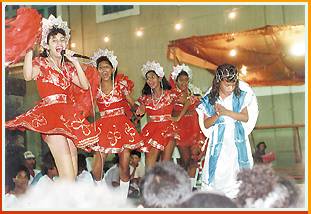
THE SHINING STAR
PASTORAL. Newspaper photo archives |
 |
Very soon
after, they began to be presented in France and England, where they
gradually transformed into medieval liturgical dramas. They were
divided into three main sections : The heralding of Christ's
arrival, the adoration of the Kings and the slaughtering of the
innocent. The first two themes remained intact and quickly spread
throughout western Europe and Portugal, thanks to the Jesuits, who
finally brought them to the Brazilian colony. |
THE
NATIVITY SCENE
Nativity scenes only appeared in the 18th.
century with the Umbrian religious movement, and traditionally, pastorals
were danced in the immediate foreground of these scenes. The invention of the Nativity scene is
attributed to Saint Francis of Assis. Around 1510, the theme was taken up
and appeared in small dramatic plays such as those by Sybilla Cassandra
and Gil Vicente, as cited by Pereira da Costa. In Portugal, presentations
of the nativity plays were not recorded until the end of the 18th. century.
Citing Pedro Fernandes Tomás, Mario de Andrade observes that, " the
'Pastoral Autos' (see explanation of 'Auto' below) or The Pastoral Nativity
plays, as they were commonly known, were theatrical compositions that were
performed in numerous localities around the country during the Christmas
festivities, New Year and Twelfth Night. They comprised a series of
small 'autos' (dramatic pieces) and were presented in private
houses
on improvised stages with very simple scenery. Very often, the scenery was
made of pine or bay tree branches spread over the walls of the stage. At
the back of the stage, the traditional grotto could be seen with the Virgin
Mary attending to the baby Jesus, with Joseph by their side. The manger
could also be seen together with the symbolic animals - the cow, the mule,
and the ass on which Mary had made her journey from Nazareth to Bethlehem.
A curtain covered the grotto, and as the ingenuous scenes of the 'autos'
would finish, so the curtain opened and the cast would fall to their
knees in reverence to the baby Jesus. The most popular farces performed between the
'autos' were - The Blind Man, the Young
Maiden, The Friar and The Pious Woman, The Sweet-Toothed Woman etc. There
was also a type of prologue in which would appear Night, the Moon, the Sun
and Attention and other symbolic entities. In ' The Three Kings Auto', Herod,
the King of Judea, would also appear ordering the slaughter of the
innocent, while remaining indifferent to the pleas of Raquel. It is thought that
these presentations date from the 18th.century and have survived in
manuscript form"
In Brazil, and more specifically in
Pernambuco, according to Pereira da Costa, the first appearance of the Nativity
scene probably took place at the end of the 16th. century, in the Franciscan
Convent of Olinda. The person responsible for this was friar Gaspar de
Santo Antônio - the first man to receive religious orders in the new
colony. Thanks to documented evidence by the Jesuit priest, Fernão Cardim,
it is possible to detect the first ever performance of the Brazilian
Pastoral on January 5th 1584 - Twelfth Night. This fact is also referred
to by Mario de Andrade in his publication Brazilian Dramatic Dances
-" Beneath an arbor, native Brazilians presented a pastoral dialogue in
the Brazilian language, Portuguese and Castilian [Spanish dialect].
They seem to take great delight in speaking the pilgrim language,
principally the Castilian. There was excellent singing, flute music and
dance, after which we all proceeded, in an inventive procession, to the
church".
THE PASTORAL IN PERNAMBUCO
It
is curious to observe that during the 17th and 18th centuries, there is no
relevant documented evidence
concerning the pastoral . However, once
the 19th century begins, there is an abundance of pastoral presentations,
especially in the Northeast of Brazil, and more specifically in the states
of Pernambuco and Bahia. These texts were actually published, as in the case of
those by Sylvio Romero and Pereira da Costa.
Mário de Andrade observes the strange fact that there were repercussions
of this dramatic dance on a national level - but only during the
eighteen hundreds when the pastoral was at its height - and then it just
seems to have disappeared. The Nativity scenes, however, remained popular and became
traditional throughout the entire country. Possibly, as Mário de Andrade
points out, this was due to the strong influence and imposition of the
elite - the bourgeoisie.
In Recife, as well as other Northeastern cities, the Pastoral
shepherdesses sang religious songs before the Nativity scene, not only
enlivening an otherwise static scene, but also adding a sense of drama to
the scene. It is clear that such presentations permitted a greater
understanding of the birth of Christ. And so, in this manner, with the
introduction of visual effects and sound, the scene began to take on life.
Hermano Borba Filho notes that this dramatization brought with it certain
literary influences from the Spanish sacramental 'autos'.
PROFANE-
RELIGIOUS
By setting off in new directions, the Pastoral Plays (Autos)
become transformed into a profane-religious syncretism, and as in most
cases, with an even stronger emphasis on the profane. This was responsible for
the introduction of new elements, especially the licentiousness of the Old
Shepherd and the sensuality of the
Shepherdesses.
In Recife, circa 1840, societies began appearing with the aim of producing
Nativity plays of the Messiah with solemnity, brilliance and decency. Such
theatrical presentations, by groups such as The Christmas Society and The
New Pastoral Society were recorded by Perreira da Costa. With the
formation of these new societies, the pastorals began to take on a
literary form. Poetry would be
recited, and authors and song writers created lyrics and music. Out of
many who contributed, the two brothers João and Raul Valença deserve special mention. Every year they were responsible for a Nativity play very
similar to those of the eighteen hundreds. Ascenso Ferreira reveals that
in Recife, the grandfather of the Valença brothers played in a Nativity play for the first
time at the height of the Paraguayan war in 1865. The
tradition was maintained until 1900 by the brothers' father, who after a
short interrupted period, brought back the nativity plays in the grounds of
their small estate with the same characteristics as the sacramental 'autos'
. The characters that the brothers used in their plays were : Guilt,
Liberty, Religion, Grace, Gabriel, Shepherdesses, Lusbel -the force of
evil, The
Mistress, Diana, The Assistant Mistress, Eve, Argemiro, The Monk, Flora,
Herod, A Centurion, and Cingo.
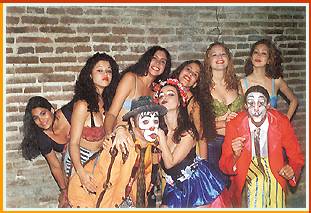
SHEPHERDESSES FROM
THE PLAY "MANGABA COM CATUABA". Newspaper archives |
 |
It is
clear that, although these societies did all in their power to
maintain moral dignity and religiousness, and avoid burlesque or
lurid scenes, the so-called profane pastorals were to be found on
almost every street corner. They were considerably altered from
their original form, and they counted on audience participation to
enliven the scenes. They escaped from the storyline and theme, and
according to many 'separatists', were irreverent, licentious and
immoral.
|
The effort
of the societies to try and maintain an air of serenity in the sacred acts
that they presented also caught the attention of the local press. The
newspapers of the time heavily censured the indecency of certain nativity
plays that were being performed. They even suggested that the
police should intervene and stop such presentations, in order to keep
moral order and respectful customs. There are records from 1840 of such
complaints, for example, those from the newspaper O Carapuceiro
written by Friar Miguel do Sacramento Lopes Gama, known as Father
Carapuceiro and famous for his criticisms of certain customs at the
beginning of the 19th century.
It is for sure that the Pastoral had its
greatest moments during the first twenty five years of the 20th century.
There were numerous lay presentations that did not lose any of their
religious connotations, principally those of the Christmas Cycle. The Nativity Plays were always performed by
'young girls of good
families', who, dressed as shepherdesses, would collect offerings such
as flowers, cakes, perfume and fruit, which would become the prizes at
auctions to raise funds for religious institutions or charities.
From this moment, the pastorals began to
spread throughout all the districts of the city, always certain of attracting a
participative public. Of course, the more licentious the pastoral
became, then the more it would attract the men. Within the structure of the 'auto',
the shepherdesses with their tambourines or maracas, sang and danced to
the sound of a string and wind orchestra, although the structure of the
group very much depended on the financial position of the group. Some of
the groups were able to afford cornets, trombones, clarinets and drums.
Others were accompanied by violins and ukuleles, with a soloist wind
instrument.
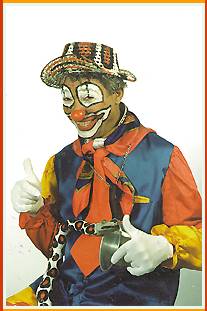
THE OLD MAN - XAVECO.
Jaime Photographs |
 |
In
between the two lines, each commanded by their Mistress (in
the blue line) and the Forewoman (the incarnate/red line), we find Diana, who is dressed half red, half blue. The Old Man, known
by the name Bedegueba, but also by numerous other nicknames, is a
kind of buffoon, a circus clown. He commands the 'jornadas'
(the shepherdess' songs) and tells many jokes and runs the
proceedings with much improvisation. His dialogues with the
shepherdesses are riddled with double meanings, and he engages in
discussions and games with the audience. He gets up to many capers and
also sings songs, which have been adapted for his own particular
needs. Amongst the other characters of the Profane Pastoral, there is
to be found the Angel and the Star of the North, the Gypsy and other
characters that can be added depending on the particular region.
Today the pastoral has lost its hieratic and lyrical sense, but has
been transformed into a popular presentational genre. It has taken
on an entirely differentiated form, which it has made entirely its own. It is
not a question of involution, but rather, an interference of the
popular performers, who with their playful and unquiet spirits have
conduced this manifestation. |
 |
THE 'AUTO'
The
'auto' tells the story of the shepherds on their way to Bethlehem,
where Jesus was born. The character, Lusbel - representing the
forces of evil, tries every within his
power to deviate the shepherds from their path. He is unsuccessful,
thanks to the interference of Saint Gabriel. Frustrated, Satan
convinces Herod to introduce the slaughter of the baby boys, but
this also fails because the soldiers actually kill his own son. Herod repents
and is saved, while the Devil, once more, is defeated.
The 'auto'
is written in verse and is performed to music. It begins with a
prologue, contains two acts and finishes with an epilogue. The
characteristics are similar to those of a sacramental 'auto', as
mentioned above. The aspect of gathering people together, one of the
strong characteristics of Northeastern popular presentations,
little by little, also began to appear. Perhaps, as Hermilo Borba
Filho points out, as well as attracting a larger public, it was also
to give the authors a greater liberty in creating their works. With
the shepherdesses divided into two groups, blue and red, there was a
possibility of forming 'supporter' groups - who would root for their
favorite color and very often end up brawling. The auction also caused
much excitement, and when the pastoral stopped being less amateur
and took on an air of professionalism, the sensuality and sexuality
were accentuated. Very often the presentation finished with either
the Mistress or the Forewoman or Diana being
kidnapped.
|
THE
'JORNADAS'
In the Nativity scenes that
maintain the traditions of Christmas, we find in the 'jornadas' -
the songs - strong allusions to the birth of Christ :
Da cepa nasceu a rama
From the vine grew the branch
Da
rama nasceu a flor,
From the branch grew the flower
E da flor nasceu Maria
From the flower was born Mary
Mãe de Nosso Senhor.
Mother of our Lord.
or even in the final songs of the
presentation, which make part of the commonly referred to section - 'the
burning of the grotto' - we come across songs with a hieratic aspect,
when the shepherdesses sing :
Vamos companheiras, vamos,
Let's go, companions, let's go,
Vamos a Belém,
Let's go to Bethlehem,
Para queimar as palhinhas
Let's go to burn the straw
Onde nasceu nosso bem. Where our Lord
Jesus was lain.
The burning of the Nativity grotto took
place almost always on Twelfth Night, when the families received guests
for the traditional midnight celebrations. They would carry all the dry
leaves, which had decorated the Nativity scene, to be burnt on a bon-fire at
the door of the church. The participants would form a circle around the
fire and they would sing the appropriate song :
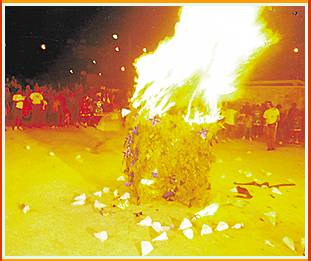 |
 |
A nossa lapinha
Our little grotto
Já vai se
queimar Is going to burn
E nós,
pastorinhas, And we, the shepherdesses
Devemos
chorar. Will surely shed a
tear.
Queimemos, queimemos, We Burn, We Burn,
A nossa lapinha,
Our little grotto scene
De cravos, de rosas,
Of cinnamon, and roses
De belas florinhas
Of such pretty posies.
Queimemos, queimemos, We Burn,
We Burn,
Gentis pastorinhas,
Sweet shepherdesses,
As secas palhinhas,
The dry straw
Da
nossa lapinha... Of our little
grotto scene.
|
This
was the time to throw onto the fire, all the written favors and requests
to the Child Jesus. After this, everyone would return home, where a plentiful supper was waiting for
them and the fun would continue. However, in the
so-called Profane Pastoral it is only the opening and closing songs that
make any reference to the birth of Christ. And even then, not always.
Amongst the innumerous versions of the opening songs, they are still sung
in the following fashion :
Boa-noite,
meus senhores todos
Good evening to all the gentlemen
Boa-noite, senhoras também;
Good evening ladies too;
Somos
pastoras
We are shepherdesses
Pastorinhas belas
Pretty little shepherdesses
Que alegremente
Who are happily
Vamos a Belém.
On our way to Bethlehem
Sou a Mestra
I am the Mistress
Do Cordão encarnado
Of the Red Line
O meu cordão
I know how to dominate
Eu sei
dominar
My line
Eu peço palmas
I ask for applause
Peço riso e flores
I ask for smiles and flowers
Ao partidário
And to our supporters
Eu
peço proteção.
I ask protection.
Sou a contramestra
I am the Forewoman
Do cordão azul
Of the Blue line
O meu
partido
I know how to dominate
Eu sei dominar
My group
Com minhas danças
With my dances
Minhas
cantorias
With my songs
Senhores todos
Ladies and Gentlemen
Queiram desculpar
I ask your forgiveness
Diana, while she is the
mediator, sang:
Sou a Diana, não tenho partido
I am Diana, I have no group
O meu partido são os dois
cordões,
My group is the two lines
Eu peço palmas, fitas e flores
I ask for applause, ribbons and flowers
Ó meus senhores, sua
proteção.
And ladies and gentlemen, your protection.
It
is important to add that these choreographed songs appear one after the other, with no dialogue or texts to link
them, except for when the Old Man irreverently interferes in the
proceedings with his improvisations to stimulate the public, or to receive
any tips that might be thrown to him.
Today, in
terms of being a popular show, the pastoral has lost much ground, and it
is difficult to find many groups bringing this traditional pleasure to the
neighborhoods of the city, on improvised stages in the local square. It is
common to hear people saying, "you don't see pastorals at the end of
the streets like you used to any more, bringing their popular, irreverent
happiness". This manifestation has lost its social function, and
sadly we have also lost many of those familiar, popular actors who
performed the part of the Old Man, actors such as :Amaro Canela de Aço, Catota, Galo Velho, Cebola, Baú,
Velho Barroso, Futrica and Faceta.
However,
even though certain economic and social factors have been responsible for the
decadence of the pastoral, it is important to remember the resistance of
the famous 'Old Man Xaveco and his Shepherdesses'. He has issued new CD's
and theatre shows have been presented. Also, the actor Walmir Chagas has
recreated the famous old character of The Old Man Mangaba.

|